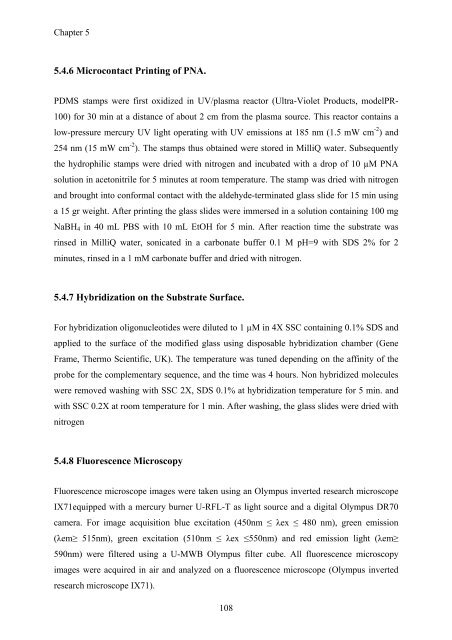View - DSpace UniPR
View - DSpace UniPR
View - DSpace UniPR
You also want an ePaper? Increase the reach of your titles
YUMPU automatically turns print PDFs into web optimized ePapers that Google loves.
Chapter 5<br />
5.4.6 Microcontact Printing of PNA.<br />
PDMS stamps were first oxidized in UV/plasma reactor (Ultra-Violet Products, modelPR-<br />
100) for 30 min at a distance of about 2 cm from the plasma source. This reactor contains a<br />
low-pressure mercury UV light operating with UV emissions at 185 nm (1.5 mW cm -2 ) and<br />
254 nm (15 mW cm -2 ). The stamps thus obtained were stored in MilliQ water. Subsequently<br />
the hydrophilic stamps were dried with nitrogen and incubated with a drop of 10 µM PNA<br />
solution in acetonitrile for 5 minutes at room temperature. The stamp was dried with nitrogen<br />
and brought into conformal contact with the aldehyde-terminated glass slide for 15 min using<br />
a 15 gr weight. After printing the glass slides were immersed in a solution containing 100 mg<br />
NaBH 4 in 40 mL PBS with 10 mL EtOH for 5 min. After reaction time the substrate was<br />
rinsed in MilliQ water, sonicated in a carbonate buffer 0.1 M pH=9 with SDS 2% for 2<br />
minutes, rinsed in a 1 mM carbonate buffer and dried with nitrogen.<br />
5.4.7 Hybridization on the Substrate Surface.<br />
For hybridization oligonucleotides were diluted to 1 µM in 4X SSC containing 0.1% SDS and<br />
applied to the surface of the modified glass using disposable hybridization chamber (Gene<br />
Frame, Thermo Scientific, UK). The temperature was tuned depending on the affinity of the<br />
probe for the complementary sequence, and the time was 4 hours. Non hybridized molecules<br />
were removed washing with SSC 2X, SDS 0.1% at hybridization temperature for 5 min. and<br />
with SSC 0.2X at room temperature for 1 min. After washing, the glass slides were dried with<br />
nitrogen<br />
5.4.8 Fluorescence Microscopy<br />
Fluorescence microscope images were taken using an Olympus inverted research microscope<br />
IX71equipped with a mercury burner U-RFL-T as light source and a digital Olympus DR70<br />
camera. For image acquisition blue excitation (450nm ≤ λex ≤ 480 nm), green emission<br />
(λem≥ 515nm), green excitation (510nm ≤ λex ≤550nm) and red emission light (λem≥<br />
590nm) were filtered using a U-MWB Olympus filter cube. All fluorescence microscopy<br />
images were acquired in air and analyzed on a fluorescence microscope (Olympus inverted<br />
research microscope IX71).<br />
108
















